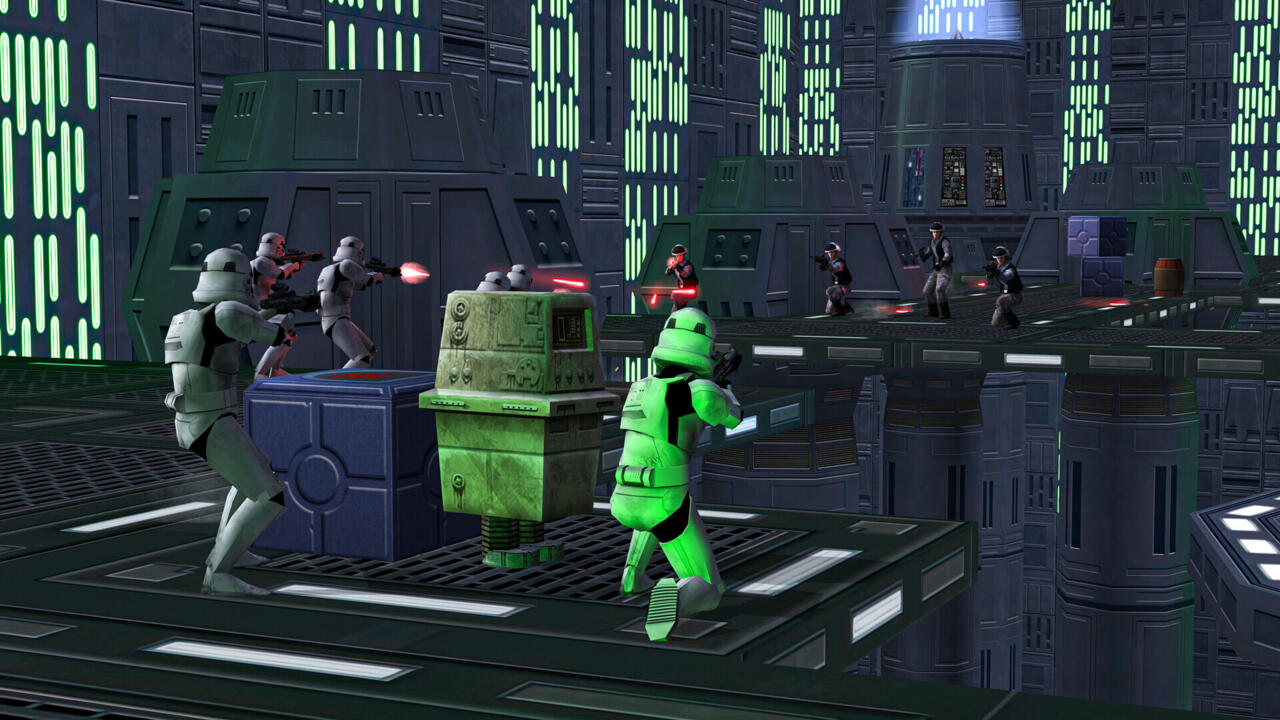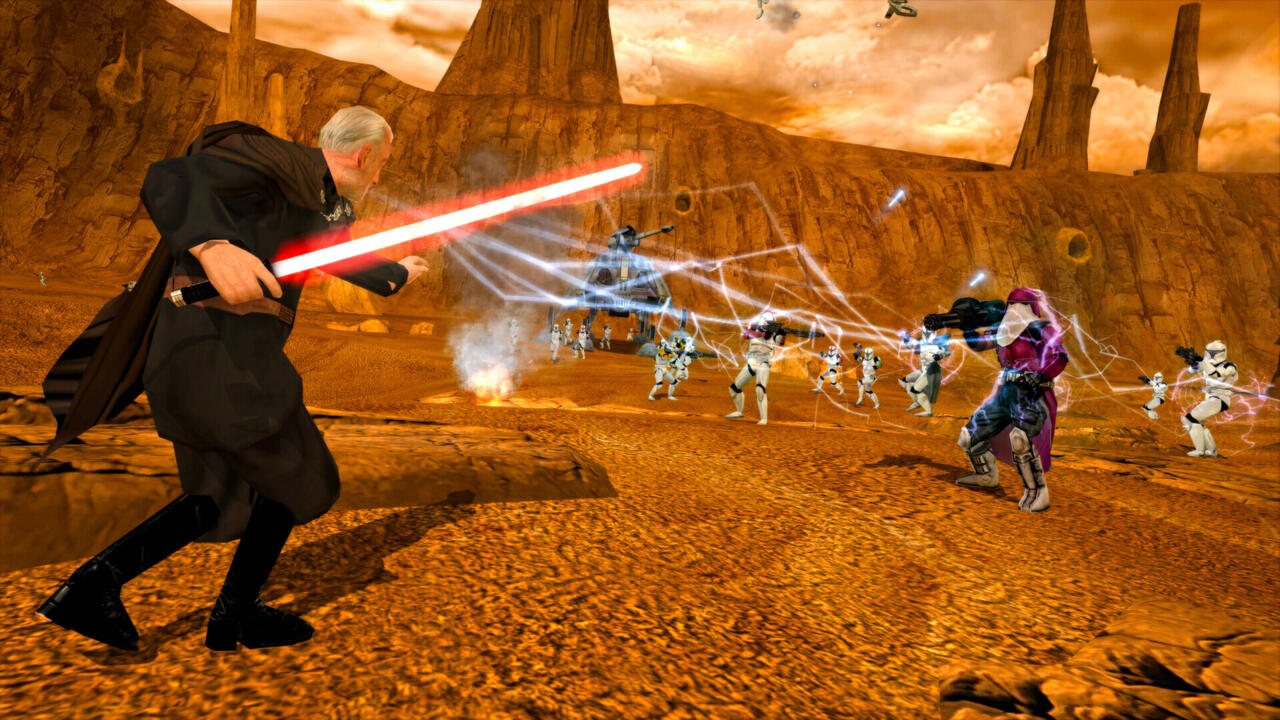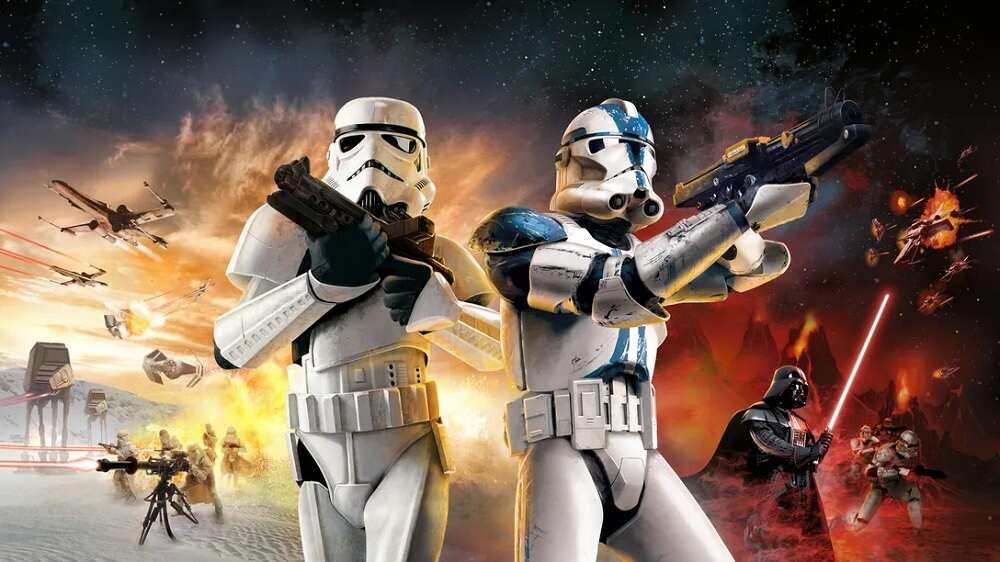I spent many a weekend afternoon playing the first two Battlefront games back in 2004 and 2005, my friends and I sinking hundreds of hours into our repeated efforts to conquer the galaxy, recreate battles from the Star Wars movies, and theorize why the video game version of General Grievous was so much stronger than his movie counterpart. Heck, my hope that we’d one day see a Clone Wars animated series that focused on exploring the clones’ individuality was born from Battlefront 2’s wonderfully narrated 501st Journal. Now that I think about it, much of my love for Star Wars can be traced back to the first two Battlefront games. But that doesn’t change that their dated mechanics and the unbalanced nature of their unrewarding tug-of-war matches don’t hold up two decades later. And Aspyr Media does not address these issues in Star Wars: Battlefront Classic Collection, a collected pack of the two games, leaving them feeling like relics of a bygone era that aren’t worth playing in this shape today.
Pandemic Studios’ Battlefront and Battlefront 2 (not to be confused with EA DICE’s 2015 Battlefront and 2017 Battlefront 2) are both shooters that focus on Star Wars’ Clone Wars and Galactic Civil War periods, seeing you step into the boots of ordinary soldiers who participate in the conflicts. Mechanically, both games play very similarly to one another, though Battlefront 2 adds to the first with space battles, playable heroes (who are notable characters from the Star Wars movies like Yoda and Darth Vader), and a more story-driven campaign that ties into Revenge of the Sith.
Continua após a publicidade..
Each army features four standard soldier archetypes. You’ve got your assault rifle-wielding standard trooper, long-range sniper user, heavy-hitting rocket launcher demolitionist, and a support soldier who excels at short-range combat and fixing up vehicles. Beyond those four, each army has additional special units–the Republic Clone Army has the jetpack-equipped Jet Trooper, for example, while the CIS has the roly-poly Droideka. Because the main units all handle the same for the most part, you don’t have to learn entirely new mechanics for each class, while the more specialized troopers add a bit of distinct flair to each army. I like it–it makes it easy to pick up both games while also ensuring the gameplay doesn’t grow stale quickly.
The collection includes six maps that were added as post-launch content to both games (one for Battlefront and five for Battlefront 2) as well as two playable heroes in Battlefront 2 who were previously Xbox-only DLC (Kit Fisto and Asajj Ventress). Beyond that, there are some changes to the gameplay, such as to Hero Assault, a Battlefront 2 game mode that sees all the playable Star Wars heroes face off against the villains. In the original Battlefront 2, this mode could only be played on the game’s Tatooine map, but the Battlefront Collection makes the mode available on all ground-based maps. In addition, the collection adds cross-gen multiplayer support (but no cross-play, unfortunately) and increases the number of players per match to 32v32.
Continua após a publicidade..
It’s those improvements that irk me, as they’re evidence that Aspyr Media did make efforts to change and improve aspects of the original games. And that’s good! Great, even. But this decision throws what wasn’t adjusted into stark contrast and highlights how outdated Battlefront and Battlefront 2’s gameplay is. It locks the Battlefront Collection into this weird space where it’s neither a good remaster nor a completely accurate preservation of the original games.

But even without that observation, it’s clear that what was once great gameplay for a console shooter has lost its luster after 20 years. Battlefront 2 fares a tad better than the original game, given how it was able to make improvements to the first Battlefront’s mechanics back in 2005–soldiers can sprint, the details of characters are sharper so it’s easier to discern targets from further away, and maps are larger so firefights are more spread out. Plus, Battlefront 2 just has a more compelling campaign. Even if the story is no longer part of the Star Wars canon, witnessing the rise of the 501st Legion during the Clone Wars and subsequent transformation into Vader’s Fist during the Galactic Civil War is still a compelling viewpoint for the Clone Troopers’ view of the Star Wars movies, strengthened by the chilling narration of actor Temuera Morrison (Attack of the Clones’ Jango Fett, The Book of Boba Fett’s Boba Fett). His monologue of the troopers’ silence as they march into the Jedi Temple to execute Order 66 is still one of my favorite moments from any Star Wars story, and 20 years later, it hasn’t lost its impact.
Continua após a publicidade..
Even if the story is still interesting to experience, however, the act of playing through it isn’t all that fun. Movements are sluggish and aiming isn’t precise, promoting the use of soldiers armed with automatic weapons over the others. The other classes are serviceable, but the gameplay clearly pushes you away from them, making every firefight feel increasingly the same. There’s no incentive to branch out and master the other classes–victory is achieved by whittling down the other team first, so killing as many people as fast as you can is ideal, and that’s just easier with an assault rifle or minigun than a sniper rifle or pistol.
Battles in the offline campaign and online multiplayer also suffer from imbalance–once one side takes the lead, they almost always win. It’s clear there’s meant to be some sort of tug-of-war element to each match, as each side fights over command posts, but it rarely plays out that way. Your side can only spawn from command posts your side has captured, so once one side has more command posts than the other, it’s easier for that side to pressure the losing side as the number of places where the losing side can spawn shrinks. This creates a slog where it becomes quite clear about halfway through a match which side is going to take the win, and you’re just left playing out the rest of the time to witness a conclusion that you saw coming. Heroes alleviate this a bit in Battlefront 2. If a player does well enough before being killed, they can spawn as their army’s hero for that map, and certain heroes can change the tide in an instant (especially the villains on the CIS and Empire, who are all around stronger than the good guys for the Republic and Rebellion). This would be a great counterbalance to the uneven nature of Battlefront 2 if heroes could be summoned more regularly but, as is, they’re just too tricky to unlock if you’re on the losing end of a battle. It’s hard to do well when the enemy is closing in around you. This issue is even worse in the original Battlefront, which doesn’t have playable heroes.

The moment-to-moment gameplay of each match isn’t all that fun either. Firearms aren’t very precise, relying on a generous auto-aim feature that feels like it’s rewarding me for pointing my gun roughly in the right direction instead of actually landing a precise shot. When I was a kid, I was always just happy that my friends and I won, but now as I see the “victory” message splash across the screen, all I can wonder is how it happened. I can’t point to what in my performance led to my team winning as opposed to losing, leaving little opportunity to think back and improve. There’s an uncomfortable amount of luck associated with victory–more than I want in a shooter.
The space battles in Battlefront 2 don’t feel much better. It’s telling that the campaign still lets you skip them outright if you want, like an admission that they aren’t very fun (which is true). Though the concept of manning a starship and flying out to meet the enemy, whittling away at their capital ships or flying into their hangar to sabotage their systems from the inside is initially thrilling, it very quickly loses its appeal once you realize all matches play out pretty much the same. There’s next to no variety to Battlefront 2’s different space maps, so your strategy for one tends to work on all of them–you don’t have to adapt, leaving the gameplay feeling stagnant. Plus, the starships in Battlefront 2 don’t handle very well, making it frustratingly tricky to maneuver through dogfights.
The biggest detriment against the Battlefront Classic Collection is that we’ve had more Star Wars games since their release that all improved upon what Battlefront and Battlefront 2 did. EA DICE’s two Battlefront games have sharper shooting mechanics that better reward precision and huge battlefields that prevent one side from quickly surrounding and destroying the other. 2020’s Squadron’s aerial dogfights are huge improvements over Battlefront 2’s space battles, with more responsive controls and greater variety to the maps. Sure, Battlefront Collection brings these elements together, but not in a way that’s strong enough to make this a more compelling experience than what’s already out there.
Star Wars: Battlefront Classic Collection is ultimately just disappointing. It’s unclear whether it wants to be a remaster or a collection that preserves two major games from Star Wars’ history, but in both instances, it fails. This is neither an accurate representation of what Battlefront and Battlefront 2 were, nor does it make enough adjustments to bring two decades-old games into the modern era. The result is a collection that’s not really fun to play, and well worth skipping.


